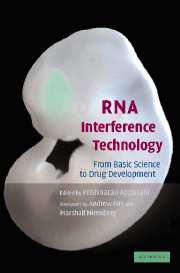Book contents
- Frontmatter
- Contents
- Foreword by Andrew Fire
- Foreword by Marshall Nirenberg
- List of Contributors
- Introduction
- Section one Basic RNAi, siRNA, microRNAs and gene-silencing mechanisms
- Section two Design, synthesis of siRNAs
- Section three Vector development and in vivo, in vitro and in ovo delivery methods
- 10 Six methods of inducing RNAi in mammalian cells
- 11 Viral delivery of shRNA
- 12 siRNA delivery by lentiviral vectors: Design and applications
- 13 Liposomal delivery of siRNAs in mice
- 14 Chemical modifications to achieve increased stability and sensitive detection of siRNA
- 15 RNA interference in postimplantation mouse embryos
- 16 In ovo RNAi opens new possibilities for functional genomics in vertebrates
- Section four Gene silencing in model organisms
- Section five Drug target validation
- Section six Therapeutic and drug development
- Section seven High-throughput genome-wide RNAi analysis
- Index
- Plate section
- References
10 - Six methods of inducing RNAi in mammalian cells
Published online by Cambridge University Press: 31 July 2009
- Frontmatter
- Contents
- Foreword by Andrew Fire
- Foreword by Marshall Nirenberg
- List of Contributors
- Introduction
- Section one Basic RNAi, siRNA, microRNAs and gene-silencing mechanisms
- Section two Design, synthesis of siRNAs
- Section three Vector development and in vivo, in vitro and in ovo delivery methods
- 10 Six methods of inducing RNAi in mammalian cells
- 11 Viral delivery of shRNA
- 12 siRNA delivery by lentiviral vectors: Design and applications
- 13 Liposomal delivery of siRNAs in mice
- 14 Chemical modifications to achieve increased stability and sensitive detection of siRNA
- 15 RNA interference in postimplantation mouse embryos
- 16 In ovo RNAi opens new possibilities for functional genomics in vertebrates
- Section four Gene silencing in model organisms
- Section five Drug target validation
- Section six Therapeutic and drug development
- Section seven High-throughput genome-wide RNAi analysis
- Index
- Plate section
- References
Summary
Using siRNAs to silence gene expression
The capacity to utilize a cell's naturally occurring RNA interference (RNAi) pathway to silence target gene expression has precipitated a new era in functional genomic research (McManus and Sharp, 2003; Dillin, 2003). RNAi can be induced in mammalian cells by small interfering RNAs (siRNAs) that target complementary mRNAs for degradation. Because of its specificity, reproducibility, and ease of use, RNAi is greatly accelerating the functional characterization of disease-relevant genes for drug discovery, target validation, and basic research efforts.
There are six basic methods for generating siRNAs. siRNAs can be prepared in vitro by chemical synthesis, in vitro transcription, or RNAse III/Dicer digestion of long double-stranded RNAs (dsRNAs). The in vitro prepared siRNAs can then be delivered to mammalian cells by a variety of methods including lipofection and electroporation. Alternatively, siRNAs can be expressed in mammalian cells from DNA plasmids, viral vectors, or PCR products bearing an siRNA template adjacent to a compatible promoter. As with the in vitro prepared siRNAs, DNA plasmids and PCR products can be delivered to mammalian cells by a variety of methods – methods such as transfection agents and electroporation. Viral vectors, on the other hand, are first packaged into viral particles that are then used to infect cells.
Various methods for inducing RNAi in mammalian cells are described in the following sections. The relative advantages and disadvantages for each method are discussed. In addition, design criteria for both siRNAs and siRNA expression templates are described.
Information
- Type
- Chapter
- Information
- RNA Interference TechnologyFrom Basic Science to Drug Development, pp. 147 - 160Publisher: Cambridge University PressPrint publication year: 2005
